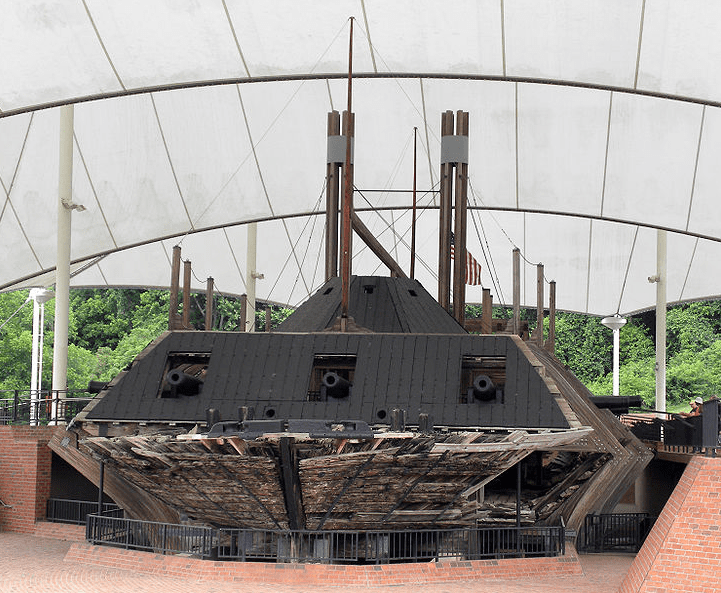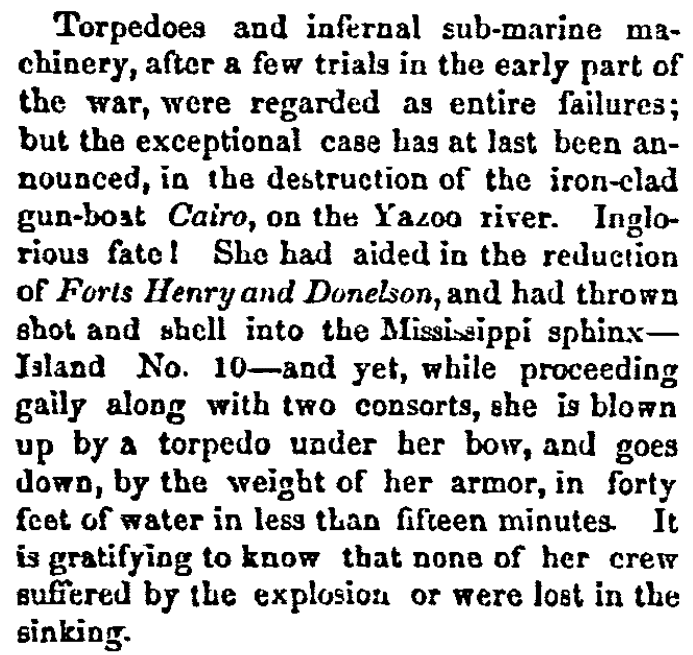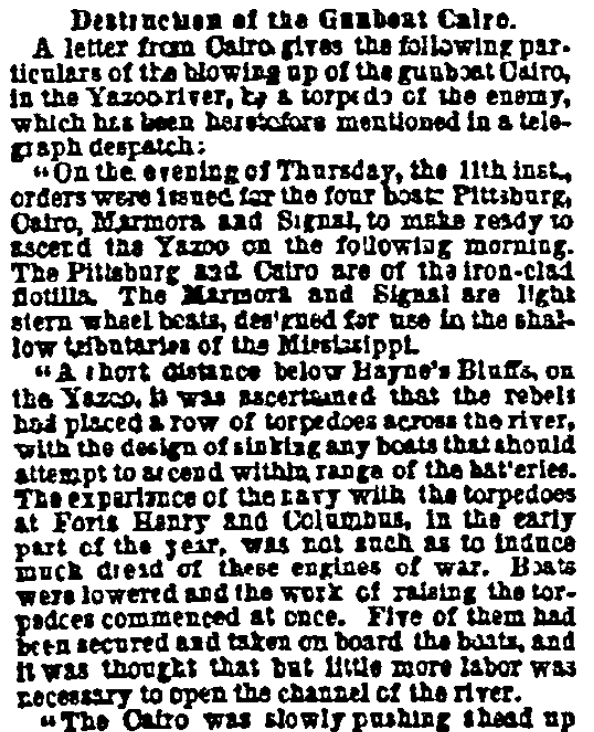The Civil War spurred many innovations in military technology and several notable “firsts” were achieved – one of the most significant being history’s first clash of ironclad warships, when the U.S.S. Monitor and the C.S.S. Virginia (a.k.a. Merrimac) fought on 9 March 1862 in the Battle of Hampton Roads. Later that same year, an ironclad warship experienced another first in military history when the U.S.S. Cairo was sunk by an electronic mine in the Yazoo River on 12 December 1862.

The Cairo, along with three other Union gunboats, was on a mission to destroy a Confederate battery on Haines Bluff, Mississippi. The Southern cannon posed a threat to Union shipping and the decision was made to destroy them. Before reaching the bluff, the Northern ships encountered a series of “torpedoes” (mines) the Confederates had strung across the Yazoo River.
Mines had been used earlier in the Civil War but to little effect. As they had done before, the Union sailors simply dragged the river and carefully removed the mines. Five of them had been secured that fateful day when suddenly the sixth exploded under the bow of the Cairo, sinking the powerful armored ship in 12 minutes. There were no casualties, but something very significant had occurred.

The mine had been set off by men hiding nearby in the bushes who sent a spark via a galvanic battery to detonate the mine. It was the first time in history a ship had been sunk by a mine detonated electronically, and a new military weapon was born.
The following four newspaper articles show how the news was given to the public. The first article is one of the earliest announcements of the Cairo’s sinking. The second is an editorial lamenting this new type of warfare with its “infernal sub-marine machinery.” The third is a letter giving many details of the Cairo’s demise, and the fourth article is a Southern editorial sneering at Northern accounts of the sinking.

Here is a transcription of this article:
A GUNBOAT SUNK BY A TORPEDO.
CHICAGO, Dec. 18. – A special Cairo [Illinois] despatch [sic] says that the gunboat Cairo, when twenty-one miles below the mouth of the Yazoo river on Friday last, was blown up by a torpedo sunk in six fathoms of water. No one was hurt, but the entire armament and outfit were lost. It is thought that the torpedo was set off by a galvanic battery on the cliffs opposite.
NEW YORK, Dec. 18. – A special despatch to the Tribune, dated at Cairo, December 18th, says: “On Friday last the gunboats Cairo, Marmora, and Signal, when ascending the Yazoo river, had reached a point one mile below Hayne’s Bluff, when a torpedo exploded under the Cairo, shattering her bow. She sunk in fifteen minutes in forty feet of water, and cannot be raised. No lives were lost. The Cairo was one of the first seven ironclad gunboats built for service on the Western rivers, and participated in the capture of Forts Henry and Donelson.”

Here is a transcription of this article:
Torpedoes and infernal sub-marine machinery, after a few trials in the early part of the war, were regarded as entire failures; but the exceptional case has at last been announced, in the destruction of the ironclad gunboat Cairo, on the Yazoo river. Inglorious fate! She had aided in the reduction of Forts Henry and Donelson, and had thrown shot and shell into the Mississippi sphinx – Island No. 10 – and yet, while proceeding gaily along with two consorts, she is blown up by a torpedo under her bow, and goes down, by the weight of her armor, in forty feet of water in less than fifteen minutes. It is gratifying to know that none of her crew suffered by the explosion or were lost in the sinking.

Here is a transcription of this article:
Destruction of the Gunboat Cairo.
A letter from Cairo [Illinois] gives the following particulars of the blowing up of the gunboat Cairo, in the Yazoo river, by a torpedo of the enemy, which has been heretofore mentioned in a telegraphic dispatch.
“On the evening of Thursday, the 11th inst. [Dec. 11], orders were issued for the four boats Pittsburg, Cairo, Marmora and Signal, to make ready to ascend the Yazoo on the following morning. The Pittsburg and Cairo are of the ironclad flotilla. The Marmora and Signal are light stern wheel boats, designed for use in the shallow tributaries of the Mississippi.
“A short distance below Hayne’s Bluffs, on the Yazoo, it was ascertained that the rebels had placed a row of torpedoes across the river, with the design of sinking any boats that should attempt to ascend within range of the batteries. The experience of the navy with the torpedoes at Forts Henry and Columbus, in the early part of the year, was not such as to induce much dread of these engines of war. Boats were lowered and the work of raising the torpedoes commenced at once. Five of them had been secured and taken on board the boats, and it was thought that but little more labor was necessary to open the channel of the river.
“The Cairo was slowly pushing ahead up the stream and several men on the bow were engaged in dragging for one of the torpedoes. The apparatus used for dragging had caught upon the anchorage ropes of a torpedo, and the men had almost brought it to the surface on the port side, when an explosion took place under the bow and about four feet below the surface of the water. The force of the explosion threw up a huge column of water that thoroughly drenched the men in the immediate vicinity. A hole of considerable extent was made in the bow, the planks being loosened and torn apart, so as to admit the water at a rapid rate. The entire boat was shaken from stem to stern, and her bow was lifted so high in the air that the water swept over the portion of the stern casemate.
“The Cairo commenced filling immediately after the explosion, and sunk in less than twelve minutes. At the time of the explosion the boats of the Cairo were mostly full of men engaged in dragging for the torpedoes. All those on board rushed at once to the upper deck, and before the water had filled the interior every one had escaped.
“The Cairo sunk in twenty-nine feet [of] water, and disappeared completely from view. Her smoke stacks were fished up and her pennant was secured as it floated upon the water. Nothing else was saved from the boat. The officers lost all their personal effects. No one saved anything except what he was wearing at the time.”

This Southern commentary was originally published by the Yazoo Banner and was incorrect: there were no casualties when the Cairo went down – every man escaped.
Here is a transcription of this article:
ANOTHER YANKEE LIE.
It is generally believed that the Yankee accounts of the blowing up of an ironclad by a torpedo on the Yazoo river, are the most complete piece of mendacity that they have yet exhibited. The Yazoo Banner says:
“This account tells one lie that we know of when they say the crew all escaped safely, with the slight bruising of the pilot. Dead bodies, we know not how many, have been seen floating near the wreck, and we are certain that they arose from it.”
The Banner also has the following upon the same subject:
“We learn just before going to press, from a gentleman who conversed with an exchanged Confederate officer just from Memphis, that only six of the crew of the Cairo were saved. In our account of last week we stated that all were destroyed, but are quite willing to announce now that six out of 250 escaped. It makes no great difference.”
Note: An online collection of newspapers, such as GenealogyBank’s Historical Newspaper Archives, is not only a great way to learn about the lives of your ancestors – the old newspaper articles also help you understand American history and the times your ancestors lived in, and the news they talked about and read in their local papers. Did any of your ancestors serve in the Civil War? Please share your stories with us in the comments section.
Related Articles:

My gr-great grandfather was a Fireman 2nd Class on the Cairo. I have found his name on the muster roll by Captain Selfridge. I was pleased also to discover that among the items found within the ship was a pocket watch, with his name James Callihan etched inside. The watch was restored and is now on display at the museum for USS Cairo at Vicksburg. The crew did indeed survive and most along with Capt. Selfridge were reassigned to USS Conestoga. Sadly my grandfather succumbed to “Lung Fever” as it was known (typhus) on January 28th, 1863, about 6 weeks later. (Doug Grimes)
Thanks for writing us, Doug, and sharing your personal connection to this story with our readers! It’s fascinating to look at the photo included with this article and wonder if your gr-great grandfather is one of the men shown on the deck.